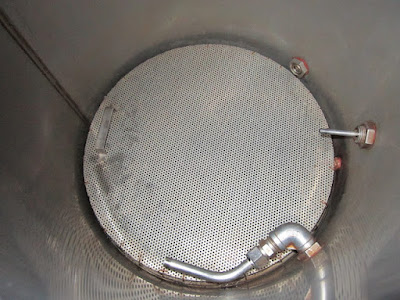One of the holy grails of session brewing is an American Pale Ale. A few breweries have been making really good sessionable, low alcohol American Pale Ales. Notch Brewing's American Session Ale is a good example of what I'm talking about. The challenge comes from making the beer flavorful & drinkable without being either cloyingly sweet or too dry. The hops can quickly overpower a low alcohol beer and throw it out of balance. Below is probably the third version of this recipe I've brewed & the first one I'm really (but not completely) happy with.
Session APA (BJCP Description)
(6 Gallons, ~80% Eff, Tinseth)
OG: 1.042
FG: 1.009
IBU: 10
ABV: 4%
SRM: 7.3
* 7.5 lbs - 2-Row Maris Otter
* 1 lb - Simpsons Medium Crystal
* .5 lbs - White Wheat Malt (Weyermann Floor Malted Bohemian Pale Wheat - 2 Lovibond)
* .5 lbs - Vienna Malt
* .25 oz Chinook (Whole) 16% FWH
* .5 oz Cascade (Whole Leaf) 8.8% @ 15 min
* .5 oz Cascade (Whole Leaf) 8.8% @ 5 min
* 1.5 oz Cascade (Whole Leaf) 8.8% @ 0 min
* 1.5 oz Chinook (Whole Leaf) 16% @ 0 min
* 1 oz Columbus (Pellets) Dry Hop for 14 Days
* Yeast:
Wyeast 1318 London Ale III - Washed
* Mashed 60 min @ 156, 1.5 qt/lb
Tasting Notes:
Look - Bright orange, off white head that sticks around (thanks hops!), slight chill haze
Aroma - Big piney-resinous and slightly citrusy hop nose. Fruity esters show up at the end.
Mouthfeel - Medium bodied, crisp with a dry finish from the hops
Taste - Bitter piney hops, sweet bready/grainy malt backbone, firm bitterness but smooth
Notes: Overall I'm getting closer to the "perfect" pale ale. This is pretty close to where I want it. I might switch out some of the medium crystal for light crystal just because it's a little dark for a pale ale but that's purely cosmetic. I'm happy with the hop schedule so now it's time to scale it down. I really want to be able to brew a 3.5% hoppy APA (easier said than done). The only change I'm going to make is to reduce the base malt. Per Jamil's writings/discussions on scaling down beers. This is to ensure the beer doesn't dry out too much.

Session APA (BJCP Description)
(6 Gallons, ~80% Eff, Tinseth)
OG: 1.042
FG: 1.009
IBU: 10
ABV: 4%
SRM: 7.3
* 7.5 lbs - 2-Row Maris Otter
* 1 lb - Simpsons Medium Crystal
* .5 lbs - White Wheat Malt (Weyermann Floor Malted Bohemian Pale Wheat - 2 Lovibond)
* .5 lbs - Vienna Malt
* .25 oz Chinook (Whole) 16% FWH
* .5 oz Cascade (Whole Leaf) 8.8% @ 15 min
* .5 oz Cascade (Whole Leaf) 8.8% @ 5 min
* 1.5 oz Cascade (Whole Leaf) 8.8% @ 0 min
* 1.5 oz Chinook (Whole Leaf) 16% @ 0 min
* 1 oz Columbus (Pellets) Dry Hop for 14 Days
* Yeast:
Wyeast 1318 London Ale III - Washed
* Mashed 60 min @ 156, 1.5 qt/lb
Tasting Notes:
Look - Bright orange, off white head that sticks around (thanks hops!), slight chill haze
Aroma - Big piney-resinous and slightly citrusy hop nose. Fruity esters show up at the end.
Mouthfeel - Medium bodied, crisp with a dry finish from the hops
Taste - Bitter piney hops, sweet bready/grainy malt backbone, firm bitterness but smooth
Notes: Overall I'm getting closer to the "perfect" pale ale. This is pretty close to where I want it. I might switch out some of the medium crystal for light crystal just because it's a little dark for a pale ale but that's purely cosmetic. I'm happy with the hop schedule so now it's time to scale it down. I really want to be able to brew a 3.5% hoppy APA (easier said than done). The only change I'm going to make is to reduce the base malt. Per Jamil's writings/discussions on scaling down beers. This is to ensure the beer doesn't dry out too much.








